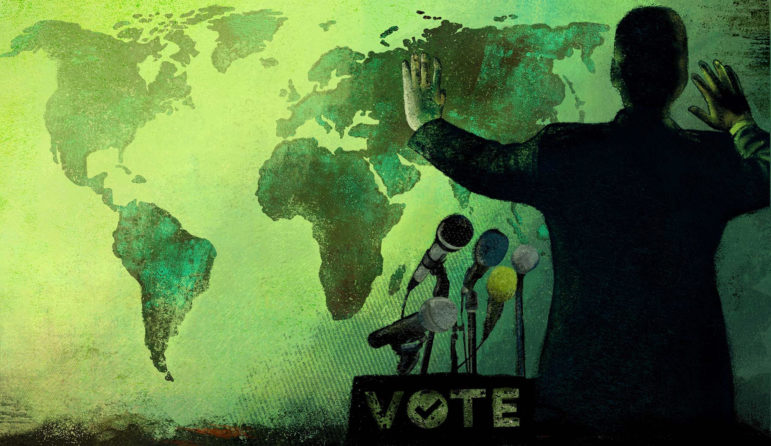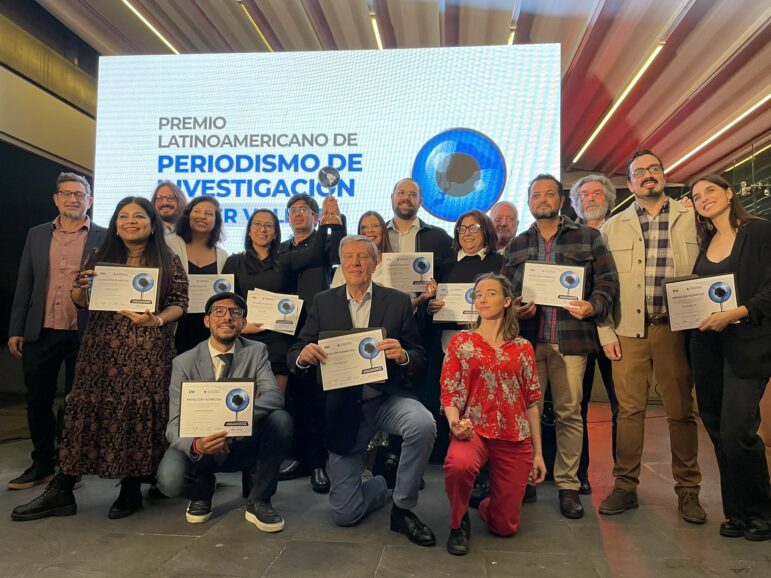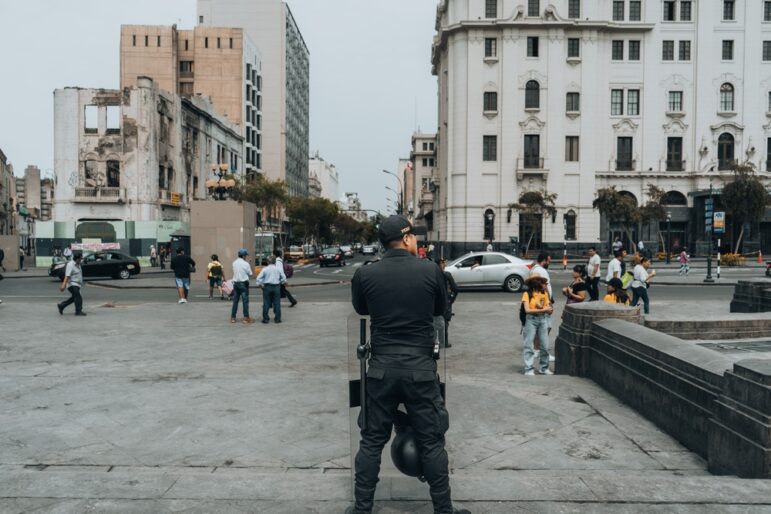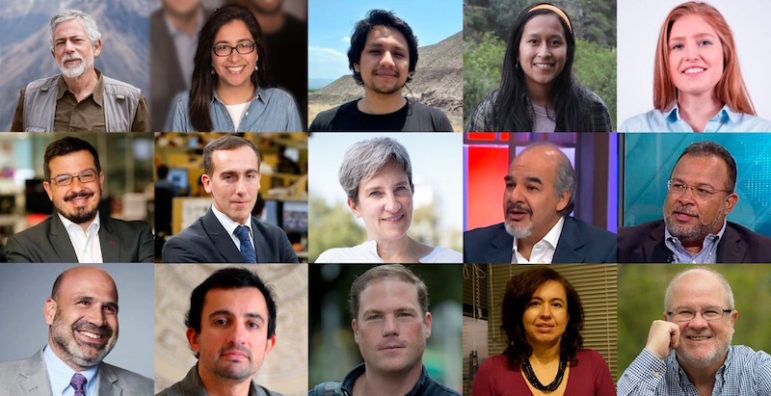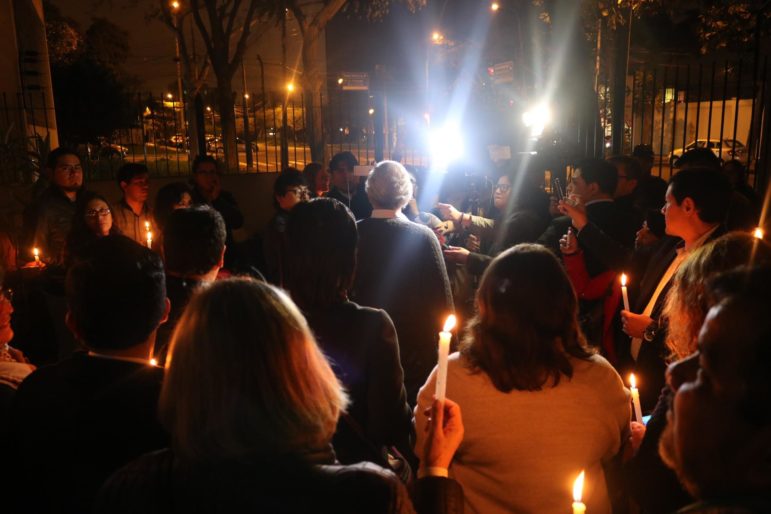

The founder and director of GIJN member IDL-Reporteros, Gustavo Gorriti, has led numerous intrepid investigations into corruption inside Peru. Image: IDL-Reporteros
IDL-Reporteros: The Newsroom That Dares to Challenge Peru’s Political Elite
Read this article in
From toppled presidents, to a multitude of arrests, and billion-dollar fines, the Odebrecht corruption scandal shook Latin America to its core.
Across the region, parties from all sides of the political spectrum received campaign financing from the Brazilian construction firm, which in the decade between 2005 and 2014 won lucrative infrastructure contracts all the way from Mexico to Argentina.
But alongside the contracts came corruption. From a starting point in Brazil, where it emerged that a car wash had been used as a money laundering front, investigators began focusing on contracts signed by the construction goliath, and the scandal spread from capital to capital.
By 2016, the firm admitted to having paid “$788 million in bribes to government officials, their representatives, and political parties in a number of countries in order to win business,” according to the US Department of Justice, which criticized a “massive and unparalleled bribery and bid-rigging scheme.” The story would become one of the biggest corporate corruption cases in Latin American history.
Peru’s political establishment was among the hardest hit by the Odebrecht scandal — besides dozens of public officials, four of its former presidents have been investigated or are being prosecuted in relation to various revelations. One of those former presidents, Alan García, locked himself in his bedroom and killed himself with a gun when police showed up to arrest him.
Investigating the scandal from the get-go was a small, independent Peruvian news outlet called IDL-Reporteros (IDL-R). Reporters there initially published their investigation as a local exposé about one of the main infrastructure contractors of Peru’s government. Later, they would help create a network of newsrooms aimed at uncovering the complete picture of Odebrecht corruption across Latin America, and would go on to receive GIJN’s Global Shining Light Award for spearheading bold and innovative investigations on the subject.

IDL-Reporteros was awarded the 2019 Global Shining Light Award for their investigations about the Lava Jato corruption case. Gustavo Gorriti is on the left, with his colleague Romina Mella. Image: Nick Jaussi for GIJN
Retribution for Reporting the Truth
Today, IDL-R — a GIJN member organization — and its founder, Gustavo Gorriti, are battling an intimidation campaign, which they say has come about in retaliation for their relentless investigations on the Odebrecht story.
“Since IDL-R began we’ve faced many hostile reactions,” said Gorriti, a veteran investigative reporter and a recipient of the Committee to Protect Journalists’ International Press Freedom Award. But the latest assault, he says, has been carefully planned using destructive disinformation tactics, and “is an attack designed to totally discredit IDL-R… and so turn investigative reporting into a crime.”
While the smear campaign has seen the outlet come under attack on various fronts, in March, the attacks escalated even further. That’s when the Attorney General’s office opened an investigation into Gorriti and some of the prosecutors who have worked on the Odebrecht money laundering and corruption investigations. It also ordered him to surrender his phone, and said it will request all messaging platforms to give them access to his communications. Gorriti now faces charges in two separate cases. In one, he is accused of conspiring with anti-corruption prosecutors related to the Lava Jato case. In a second case, there is an allegation by Fujimori’s party, still under preliminary investigation, that his reporting was responsible for inducing García’s suicide.
Willax Television — a Peruvian right-wing, Fox News-style news channel — has given extensive coverage to the claims against Gorriti. The channel is close to the Fuerza Popular party, whose leader, Keiko Fujumori, has been accused of receiving illicit campaign contributions from Odebrecht during two previous bids for Peru’s presidency. Fujimori’s trial for those allegations, which she denies, will begin in July, but the case is turning up the heat on IDL-R.
Gorriti has also been a victim of a social media disinformation campaign regarding a cancer diagnosis, physical harassment, and far-right protesters have surrounded and thrown trash at IDL-R’s headquarters.
“Although the accusations are remarkable for their stupidity, they’re set up as long-term multifaceted attacks that create a perception of wrongdoing because of their persistence and repetition,” Gorriti explains. “This attack has been the worst, the one that has mobilized the most resources, and been the longest lasting.”
The situation — and especially the threat of legal action against Gorriti — has sparked an outcry within the press. Last year, the Inter-American Court of Human Rights (IACHR) urged the Peruvian state to take measures to protect Gorriti, whose “rights were under risk of irreparable damage.” In early 2024, more than 80 journalists from across Latin America and the US expressed their support for IDL-R and Gorriti, in a letter also signed by GIJN Executive Director Emilia Díaz-Struck. In March, the US National Press Club and the National Press Club Journalism Institute led 10 journalism organizations and freedom of expression groups in a joint statement of support, which labeled the threat of legal action “a blatant attempt to muzzle one of Latin America’s best investigative reporters.”
“[Gorriti] is a hero to me and many other journalists,” said Marcela Turati, co-founder of Mexico’s Quinto Elemento Lab. “Each time the insidious campaigns against him begin because of his work, I always know they want to make him pay a high cost for doing investigative journalism.”
Filling a Vacuum Through Investigative Innovation
Gorriti is no novice to the dangers of investigative reporting. His beat in the 1980s was the violent armed conflict between the Peruvian army and left-wing rebel groups, such as Sendero Luminoso, the Shining Path. Gorriti’s book on that group — written while on a Nieman Fellowship in the US — is considered by many to be the definitive account of the war.

Gorriti wrote what many consider to be the definitive book on the Peruvian government’s war against the Shining Path. Image: Screenshot, The University of North Carolina Press
Gorriti returned to Peru just as Alberto Fujimori — Keiko’s father — was elected president and a brutal offensive against Sendero Luminoso began, using death squads and paramilitary forces.
When Fujimori dissolved Peru’s Congress and became a de facto dictator, Gorriti dug into a web of corruption surrounding the then-president, led by Fujimori’s presidential advisor, spymaster and arms dealer Vladimiro Montesinos. In 1992, Fujimori and Montesinos ordered the kidnapping of Gorriti, who was taken to a secret location and was only released when his wife alerted press freedom NGOs and the US government.
International pressure forced his release, and during the rest of the 1990s Gorriti was exiled in Panama, where he worked on strengthening Panamanian investigative journalism. His revelations about government corruption led Ernesto Pérez Ballardes, Panama’s then-president, to revoke his working license and expel him, but again because of local and international pressure, Gorriti was able to remain as an investigative journalist in Panama until he decided to return no Peru in 2001.
That same year, Fujimori’s government crumbled when tapes emerged of Montesinos bribing opposition members of Congress, and later both Fujimori and Montesinos were arrested, tried, and convicted of committing human rights violations and corruption.
After returning to Peru, in 2005 Gorriti was named head of Peru’s press freedom defense nonprofit, the Press and Society Institute (IPYS). His presidency was known for making IPYS an institution that, besides supporting Peruvian journalists, gave refuge to threatened colleagues from other countries in the region.
But Gorriti was beginning to be alarmed by the vacuum in watchdog reporting, and after a few years, decided to go back to the newsroom. “There was a crisis of investigative journalism because of the acute cuts to investigative units in newsrooms,” he said. “There was a need to create small nonprofit investigative units, especially because budgets were extremely tight.”
IDL-R was founded in 2009 by a handful of loyal journalists, such as Romina Mella, co-founder and lead editor, and the outlet’s first investigation was published in 2010. That same year, this group began to research what seemed like irregularities in contracts with the Brazilian company Odebrecht, the main infrastructure contractor working with the government, then led by President Alan García.
“We thought it was important to investigate [the contracts]. We began by talking to various sources and there were some hints regarding irregularities in the projects,” said Mella. “In 2011 we published our first piece about the company and its state contracts, and soon afterwards we published a story about the contracts between the companies of President García’s secretary-general and Odebrecht while he was a state official.”
When outlets in neighboring Brazil began publishing investigations about the car wash or “Lava Jato” scandal, IDL-R decided the only way to properly cover Odebrecht’s Latin American maze of corruption, track their money laundering routes, and establish who had received bribes, was to create an international network of journalists.
“If corruption was transnational, we believed investigative journalism should also be transnational, to build in-depth coverage from each of our countries. So we created a virtual newsroom in which we all shared information,” Mella explained.
The Odebrecht investigations brought together a dream team of Latin American investigative outlets that included the Latin American Center for Investigative Journalism (CLIP), Mexico’s Quinto Elemento Lab, Argentina’s La Nación, Brazil’s Metrópoles, Panama’s La Prensa, Uruguay’s Sudestada, and Venezuela’s Armando Info.
In addition to its Odebrecht reporting, IDL-R has delved into other aspects of the underbelly of Peruvian corruption schemes and human rights violations, kicking off in 2010 with a story on how the Peruvian army bought armored personnel carriers at inflated prices. Gorriti has stated that another key investigation conducted by the newsroom revealed a corruption network within the highest echelons of Peru’s justice system. IDL-R has also rallied investigative alliances with partner media outlets to tackle transnational stories such as the Panama Papers, the Pandora Papers, the FinCEN Files, Bribery Division, Project Rafael, and the murder of Miroslava Breach.
The team at IDL-R is still small. “Our newsroom is extraordinarily austere,” said Gorriti when asked about the staff and budget. For many years, the majority of their financing came from the Open Society Foundations’ Independent Journalism Program, but this has now ended. “We have received generous donations from other foundations, but they are few,” said Gorriti.
One self-imposed limitation on fundraising is necessary, they believe, in order to prevent any perceived conflicts of interest. “We have very strict limitations on who we receive funds from,” said Gorriti, one being that they will not take funds or grants from any national or foreign government.
Deadly Protest in the ‘City of Churches’
Even after the fallout from Odebrecht, Peru continued to see a crisis in political leadership. In 2022, then-President Pedro Castillo tried to dissolve Congress, a move seen by many as a coup attempt. Protesters rallied, clashing with security forces.
In Ayacucho, an agricultural mountain town dubbed the “city of churches” for its 33 Catholic places of worship, 10 civilians were killed after taking to the streets in protest. One of them was a 15-year-old who died when a bullet pierced his heart.
The most detailed information about what happened on December 15, 2022, came from a story by IDL-R. The investigation, by César Prado and Rosa Laura, earned them the prestigious Latin American Gabo Prize — named after Gabriel García Márquez — in 2023, and first place in the 2023 Colpin Award.
Inspired by the meticulous geolocation and image-supported investigations pioneered by organizations like Bellingcat, Colombia’s Cerosetenta, and La Silla Vacia, Prado and Laura established the exact chronology of events, pinpointing where six of the 10 deaths took place, who was in command of the units sent to quell the protests, what weapons were used, and, in some cases, even established who they believed had fired.
“All our evidence was visual, so it was logical our piece should be visual. We made a video which was something new for IDL-R, because although it’s a digital platform, we usually publish text and photographs. But there’s always room for these kinds of innovative approaches,” said Laura.

A still from the video report — Ayacucho: X-ray of Homicides — by IDL-R, investigating how a political protest turned deadly when the army was sent in to deal with demonstrators. Image: Screenshot, IDL-Reporteros
Key for Prado and Laura to understand the case was approaching the families of the victims and their lawyers, who provided them with information from prosecutors and smartphone videos with which they put together their account of what happened: when the police were overwhelmed by the number of protesters occupying Ayacucho’s airport runway, the army was called in.
“When they received these orders, they had nearly no non-lethal weapons. I believe that in many cases the soldiers that were called to repel the protestors were very young, didn’t have a lot of training, and at a certain point, the chain of command broke down and the military leadership lost control over the situation,” said Prado.
(While investigations into the way then acting-President Dina Boluarte responded that day are ongoing, the government has said that the security forces were given orders to respect human rights while recovering public order.)
“Ayacucho is journalism in its purest form,” the Gabo Prize jury stated. “People using all resources at hand — surveillance images, cell phones, and maps — to uncover and tell something others want to hide.”
The Future
Over the years, IDL-R has been raided by the Attorney General’s office, faced pressure to reveal its sources, had its journalists surveilled, and far-right organizations have held rallies in front of its headquarters.
But both Mella and Gorriti insist the crisis they are facing today is the worst yet. Gorriti warns their experiences should be seen as a cautionary tale of the challenges investigative outlets elsewhere might face, in countries where the press comes under attack and where financing of quality investigative journalism is at risk.
“This is a new kind of threat that we are facing here, that other newsrooms around the world have faced or will come up against in the near future,” warned Gorriti. “If the far-right continues to gain more influence and positions of power around the world, these threats will only grow stronger. The panorama of threats that we can see on multiple fronts is only going to increase.”
The only answer for outlets like IDL-R, he says, that do not have huge financial resources to draw on, is to keep going, with a defense grounded in the integrity of the newsroom, “in the precision, accuracy, and impact of its data, in the capacity to answer, and in the solidarity of other international media.”
 Santiago Villa is an award-winning journalist who has written for Latin American news outlets for more than a decade. He is currently based in Colombia, and writes an opinion column for El Espectador. He has previously worked as a foreign correspondent in South Africa, China, Venezuela, and Ecuador.
Santiago Villa is an award-winning journalist who has written for Latin American news outlets for more than a decade. He is currently based in Colombia, and writes an opinion column for El Espectador. He has previously worked as a foreign correspondent in South Africa, China, Venezuela, and Ecuador.


